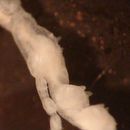en
names in breadcrumbs


Length: 7-16 mm. Body smooth except for antero-lateral projections on pereonites 3 and 4, and median dorsal paired spines on pereonite 5; there may also be dorsal paired spines on pereonites 5 and 7. Antenna 1 shorter than cephalon plus pereonite 2, peduncle slightly setose; antenna 2 shorter than two basal articles of antenna 1, swimming setae sparse, and absent on flagellum. Gnathopod 1 with serrate grasping margin to propodus and dactylus. Gnathopod 2 propodus nearly three times as long as broad, and longer than basis; palmar surface with proximal grasping spine plus two accessory spines, one on each side of palm, distal triangular projection, and large anteriorly pointing poison spine midway between grasping spine and distal projection; antero-distal end of propodus with two projections which jut out on either side of base of claw. Dactylus almost straight proximally, sharply curved distally and with denticulations along inner edge. Basis attached posteriorly on pereonite 2 and having antero-lateral projection. Gills small, oval. Pereopods 5 - 7 increasing in size, propodus with proximal grasping spines. Female differs from male in antenna 2 longer than peduncle of antenna 1; gnathopod 2 propodus not elongated nor extended anteriorly, palm having proximal grasping spine and two accessory spines, distal minute poison spine and more distal rounded projection; dactylus heavy and evenly curved.
Korea; Unalaska, Alaska; British Columbia; Washington
Caprellid, “Ghost” or “Skeleton” shrimps, so called for their skeletal appearance. Amphipod crustaceans, easily distinguished by the elongate stick-like body form and reduction of the abdominal appendages. Head is generally fused with pereonite 1. Pereopods on first 2 segments (pereonites) are most flexible and called gnathopods; gnathopods 2 being the largest, used in defense, feeding and substrate attachment. In many species pereopods 3 and 4 may also be reduced or absent. Gills on pereonites 3 + 4, rarely on pereonite 2. Pereopods 5 - 7 much smaller than 1 + 2, used for clinging to the substratum. In females, brood plates (öostegites) develop on pereonites 3 + 4. Much remains to be learnt about their biology, ecology and in many cases changing distributions.
10-200m
Males of this species are easily distinguished by Gnathopod 2; females are very similar to C. laeviuscula, but differ in having two accessory spines at the base of gnathopod 2 grasping spine (C. laeviuscula only having one).
National Museum of Natural History, Washington DC: (NMNH) 25906